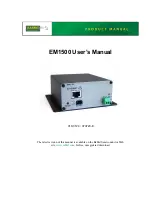
-
ageing after a considerable number of working hours;
-
overheating caused by thermostatic capsule failure.
Probable cause:
-
discontinuation in snubber network;
-
fault in driver circuit;
-
poorly functioning thermal contact between IGBT and
dissipator (e.g. loosened attachment screws: check);
-
excessive overheating related to faulty operation.
Probable cause:
-
excessive overheating related to faulty operation.
Probable cause:
-
discontinuation in snubber network;
-
poorly functioning thermal contact between IGBT and
dissipator (e.g. loosened attachment screws: check);
-
faulty output connection.
Before proceeding with faultfinding, we should
remind you that during these tests the power source is
powered and therefore the operator is exposed to the danger
of electric shock.
The tests described below can be used to check the operation
of the power and control parts of the power source.
B) Set up the multimeter in DC mode and connect the prods to
the OUT+ and OUT- bump contacts.
C) Position the potentiometer R23 on maximum (turn
clockwise as far as it will go).
D) Connect the power supply cable to a single-phase variac
with variable output 0-300 Vac.
A) Switch on the variac (initially set to the value 0 V), switch off
the main switch on the power source and increase the variac
voltage gradually to 230 Vac and make sure:
- the green power supply LED D10 lights up (
),
- the fan for the power transformer starts up correctly,
- the pre-charge relay K1 commutes (
),
- for voltages close to the rated power supply value (230Vac
±15%) the power source is not in alarm status (yellow LED
D12 off).
if the power source stays in alarm status permanently,
there could be a fault in the control board (in any case, proceed
to make the other tests)
B) Make sure the waveform shown on the oscilloscope
resembles
.
D) Set up the dual trace oscilloscope. Connect the probe
CH1(x100) to the Q8 collector and probe CH2(x10) to the gate,
also of Q8. The earth connections are both made to the emitter
of Q8.
E) Make sure the waveform displayed on the oscilloscope
resembles
IGBT's Q5, Q8 fig. 4
Primary diodes D14, D31 fig. 4
Secondary diodes D33, D34 fig. 4
6.1 Preparation for testing
6.2 Tests for the TECNICA 111
(
)
(
)
(
)
Power transformer and filter inductance (fig. 2A)
Inspect the windings for colour changes. Probable causes:
power source connected to a higher voltage than 280Vac;
ageing after a substantial number of working hours;
excessive overheating related to faulty operation.
It is important to make sure that all the connections are in good
condition and that the connectors are inserted and/or attached
correctly. To do this, take the cables between finger and thumb
(as close as possible to the fastons or connectors) and pull
outwards gently: the cables should not come away from the
fastons or connectors.
If the power cables are not tight
enough this could cause dangerous overheating. In particular,
on the power board it is necessary to make sure all the wiring is
inserted correctly into the corresponding connectors or
fastons. Also make sure that the connections to the dinse
sockets are attached correctly to the power board.
With the multimeter set on diode testing check the following
components (joint voltages not less than 0.2V):
rectifier bridge PD1 (
)
IGBT's Q5, Q8 (no short circuits between collector-gate
and collector-emitter (
));
secondary diodes D32, D33, D34 between anode and
cathode (
). The secondary diodes can be tested
without removing the power board: with a prod on the
secondary diode dissipator and the other in sequence on
the 2 power transformer OUT terminals;
With the multimeter in ohm mode check the following
components:
resistor R4: 47ohm (preload
);
resistors R46, R63: 22ohm (primary snubber
);
resistor R60: 10ohm (secondary snubber
);
continuity test for the thermostat on the power
transformer: clean the resin from the bump contacts for
ST1(J8,J9) and measure the resistance over these two
bump contacts, it should be approx O ohm. (
).
C) Set up a multimeter in volt mode and make sure that
the voltage over Test Point XT5 and the case of U3 is equal
to +15Vdc 5%;
-
the voltage over Test Point XT12 and the case of U3 is
equal to +26Vdc 5%;
-
the voltage over Test Point XT10 and the case of U3 is
equal to +5Vdc 5%;
-
the voltage over Test Point XT2 and the case of U3 is equal
to +3.7Vdc 5%;
the voltage between the cathode of diode D36 and the case
of U3 is equal to +12Vdc 5%;
-
-
-
A)
B)
1.0
Checking the power and signal wiring
N.B.
fig. 3
fig. 4
fig. 4
fig. 3
fig. 3
fig. 3
fig. 2B
(fig. 3):
5.0 Electrical measurements with the machine
switched off
6.0 Electrical measurements with the machine in
operation
-
-
-
-
-
-
-
-
-
WARNING!
fig. 3
fig. 3
NB.
Fig. A
fig. B.
A)
Set up the oscilloscope with the voltage probe x100
connected between pin 3 of Q4 and the earth on the case of U3
(
).
If this signal is absent it may be necessary to replace
component Q4 (
).
fig. 3
N.B.
fig. 3
±
±
±
±
±
- 11 -
TECNICA 111
FIGURE A
SETTINGS CH1:
· PROBE x10;
· 10 V/Div;
· 5 sec/Div.
·
: 65KHz ±10%.
· AMPLITUDE IS:
28V ±10%.
µ
VERIFY THAT:
THE FREQUENCY
IS







































